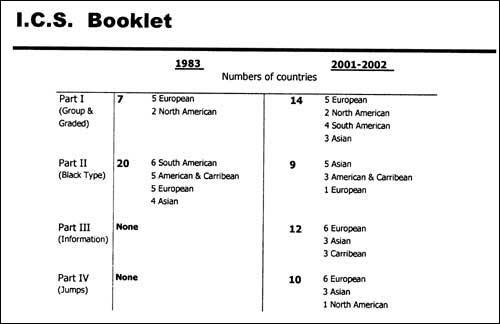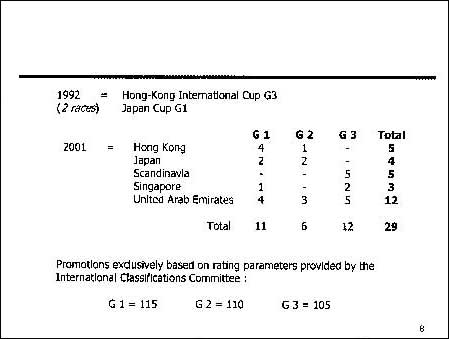History - International Cataloguing Standards Committee
INTERNATIONAL CATALOGUING STANDARDS COMMITTE (ICSC)
|
Presentation made at the 2002 Paris Conference
by
Mr Louis ROMANET
Chairman of the ICSC
|
|
|
1952
|
 Fasig TIPTON Co uses bold face types to designate stakes winners in
sales catalogue pages
Fasig TIPTON Co uses bold face types to designate stakes winners in
sales catalogue pages |
|
1960
|
 Keeneland sales adopt it
Keeneland sales adopt it |
|
1963
|
 1st edition of Cataloguing Standards for foreign racing published
by Blood Horse for 2 years and then by the Jockey Club Statistical
Bureau
1st edition of Cataloguing Standards for foreign racing published
by Blood Horse for 2 years and then by the Jockey Club Statistical
Bureau |
|
1971
|
 Creation of the European Pattern Races
Creation of the European Pattern Races |
|
1973
|
 Creation of the American Graded Stakes
Creation of the American Graded Stakes |
|
1983
|
 1st International
Cataloguing Standards Booklet 1st International
Cataloguing Standards Booklet
 Creation
of the International Cataloguing Standards Committe Creation
of the International Cataloguing Standards Committe
 Creation
of Society of International Thoroughbred Auctioneers (SITA) Creation
of Society of International Thoroughbred Auctioneers (SITA)
|
Objectives :
- To prevent discrepancies between countries in the criteria applied
for black type races in sales catalogues
- To define more objective standards in the recognition of racing quality
among the nations
- To prevent imbalances between countries in the designation of Group
or Grade and black type races.
|
Original composition :
 12 members 12 members
 4
countries : 4
countries :  3
3
representatives :
|
GB, IRE, FR, USA
- 1 Jockey Club or Turf Authority
- 1 Auction Companies
- 1 Breeders' Association |
|
|
- Established by the ICSC
- Published by the Jockey Club (US) in association with Thoroughbred
Owners and Breeders Association (TOBA) and European Pattern Commitee
- Sponsored by SITA |
|
|
1983 Peter WILLETT
1987 Count Roland de CHAMBURE
1988 Jacques WIMPFHEIMER
1992 Louis ROMANET |
|
|
1983 Sam SHEPPARD, who was also Secretary
of the English Breeders' Association
1986 Matthew Mc CLOY, who was also Secretary of SITA
1999 Carl HAMILTON, President of the Jockey Club Informations Systems
Inc. who publishes the booklet. |
|
Composition of the Committee
|
|
1983
|
- 4 countries : GB, IRE, FR, USA
- 12 Members : 9 European, 3 North American |
2001
|
- 4 founding countries
- OSAF - Asian Racing Conference
17 members : (including 5 SITA members)
9 European
6 North American
1 Asian
1 South American
|
|
|
|
| One of the major changes was the creation in 1992 of a special section
in Part I called " Other races " which listed international open races run
in countries still in Part II. The aim was to encourage the Part II countries
to create and promote international racing. |
|
|
|
*
|
|
The basic criteria taken into account for classification in Part II of
the " International Cataloguing Standards " booklet :
- The percentage of black-type races to the total number of races run
in that country (It should be no higher than 3 %).
- The ratio of the number of different horses to start in that country
to the number of black-type races (It should be no lower than 40:1).
- The percentage of black-type races which are open to foreign horses.
- The performances of the horses trained in that country when racing
abroad.
*
|
|
Future developments:
- Continuous development of Intercontinental racing in the
countries who are members of the Asian Racing Conference :
| - Australia : |
Cox Plate - Merlbourne Cup and others |
| - Hong-Kong : |
4 Group 1 and 1 Group 2 in 2001 |
| - Japan : |
From 18 races in 2001 to 24 races in 2004 opened
to foreign trained horses |
| - Singapore : |
1 Group 1 and 2 Group 3 in 2002 |
| - UAE : |
Dubai World Cup Day : |
| |
- 1996 : 10 International runners
- 2001 : 70 International runners
- 2002 : (4 Group 1 - 3 Group 2)
Creation of Classic Calendar :
- UAE 2000 and 1000 Guineas : Derby and Oaks
|
|
- Development of the World Series : 12 races, 10 countries,
4 continents
|
| |
- 1st semester : 1 race in March
- 2nd semester : 11 races between the end of July and Mid December
- 1st semester must be reviewed with additional races from Australia,
Asia, Europe
- South America should become part of it
- Possible extension to Milers and Sprinters Series |
Main benefits of World Series :
|
| |
- Promotion of racing in the media world wide
- Development of intercontinental racing
- Improvement of the International Classifications
- Increase of the prize money of the races concerned
- Incentive to keep horses in training after their 3 years old carreer.
|
- Establishment of International Classifications by continent
and world wide : Asia and South America
- Revision of Grading system in Part I countries taking into
account rating parameters
- Modification of the ground rules applied by the ICSC for
promotion of individual races since year 2000
|
| |
- Two years prior running for Group 1 and 2
- Two years prior running for Group 3 or one year under exceptional
circunstances (level of ratings, prize money) : ex. : Hong Kong
Sprint & UAE Derby
- first year Group
3 and second year Group 2.
|
- Creation of a special section in Part II of the booklet
as " Other Races " for International Races organised by Part III
countries which would then receive black type status :
|
| |
- International Races in Turkey
- Clasico International del Caribe (rotating between Part II and
Part III countries)
- Any other international race created with good quality of horses
from the country and abroad.
*
|
|
Conclusion
1983 - 2003 = 21 years since ICSC was created :
- its composition has been enlarged à its criteria are regularly
reviewed
- the international classifications are playing a key role in
the promotion of races
- all Part I countries must be included in the Classifications
and review their Grading system accordingly with the introduction
of Quality Control à
- Part II and Part III countries must be encouraged to develop
international races who could be promoted to an upper Part
|
At their annual meeting held in London on 18th June
2007, ICSC members underlined the duplication of efforts between International
Grading and Race Planning Advisory Committee (IRPAC), set up by the
IFHA Executive Council on March 2002, and ICSC. They decided that
:
- Group/Grading responsibilities should be under IRPAC with
ratification required by SITA.
- The regional ICS Sub-Committees would be responsible for catalogue
page format issues, without an international level.
|
* * *
|
|





